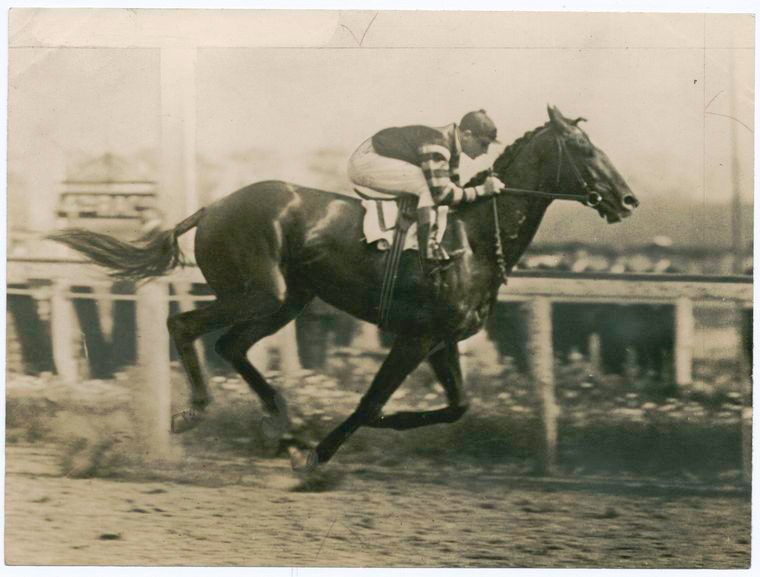
By Dawn LeFevre
On Saturday July 2, 2022 the 105th edition of the Dwyer Stakes will be run. Originally named the Brooklyn Derby and run at Gravesend Racetrack, the race quickly grew into a showcase for top three year olds, including Triple Crown champions Gallant Fox, Omaha, Whirlaway, and Assault. It’s also the race where the legendary Man O’War faced his greatest challenge. For nearly a mile the champion was locked in a head to head dual with a determined John P. Grier (who was carrying eighteen pounds less) before drawing off to win by two lengths and setting a new world record. The Dwyer Stakes has a long, fascinating history, almost as fascinating as the two brothers for which it was named – Philip and Michael Dwyer.
Phil and Mike Dwyer’s introduction into the world of racehorse ownership began not on the track but rather the confines of their successful Brooklyn meat packing plant. One of their best customers just so happened to be August Belmont, the renowned breeder of champion Thoroughbreds and founder of Belmont Park. In 1874 Belmont sold a racehorse named Rhadamanthus to the Dwyer brothers and it didn’t take long for them to get hooked by the sport. In 1876, they purchased a colt named Vigil who quickly racked up over $20,000 in earnings and Champion Three-Year-Old Colt honors. For the next fourteen years, the Dwyer Brothers Stable ruled horse racing, winning a Kentucky Derby, a Travers Stakes, and an amazing five Belmont Stakes within a six year time frame. While most traditional racehorse owners bred their runners, the Dwyer brothers would simply buy any horse that caught their eye. Indeed, they had quite an eye, purchasing and campaigning such champions as Hindoo, Hanover, Bramble, Kingston, Tremont, Sir Dixon, Miss Woodford and Luke Blackburn.
The Dwyer brothers’ reach didn’t stop at just owning racehorses, however. Phil and Mike also founded the Brooklyn Jockey Club and built Gravesend Racetrack. After gaining control of the Racing Trust, the governing horse racing authority in New York, the brothers used their power to squash competition against their own runners. After several prominent owners and trainers claimed foul, James R. Keene formed the Jockey Club in 1894. While both Dwyer brothers were allowed to become members, their iron hold over New York racing had come to an end.
While the Dwyer brothers were on the same page when it came to buying and campaigning racehorses, their temperaments couldn’t have been more opposite. Phil was a level-headed gentleman who simply loved to watch his horses run. To him, fifty bucks was a big bet. Mike
was a bettor through and through, notorious for shelling out $90,000 just to win $30,000 and wagering up to $100,000 a day. It was these diversities which led Phil and Mike to dissolve the Dwyer Brothers Racing Stable in 1890. And just like their personalities, the fate of the two
brothers after the split couldn’t have been more different.
Mike shipped a string of horses to England with catastrophic results. With his fortune gone, Mike was forced to return to the U.S. where he suffered a stroke that left him paralyzed. He spent the remainder of his life watching the races from the confines of his carriage and spouting
stories of his glory days with his champion horses to all who would listen. He died in 1906 at the age of fifty-nine having lost more than $1.5 million in wagers – $36 million in today’s money.
For Phil Dwyer, the wins just kept on coming. After splitting from his brother, Phil won the 1896 Kentucky Derby with Ben Brush and the 1899 Preakness with Half Time. In 1904 he acquired Aqueduct Racetrack, rebuilt its grandstand and increased the size of its oval. In 1913 after the
Hart-Agnew Law killed horse racing in New York, Phil simply purchased a partnership in Laurel Park and moved his stable to Maryland. Ironically, it was his love of the sport which led to his demise. On a damp, chilly day in 1917 Phil attended the opening of Belmont Park. He caught a cold which turned into pneumonia and died on June 9, 1917 at the age of sixty. One year later the Brooklyn Derby was renamed the Dwyer Stakes to commemorate the two brothers who had given so much to the sport of horse racing.
Photo: The great Man o’ War won the Dwyer in 1920. His sire, Fair Play, had also won the race in 1908. Pictured is Man o’ War in an unarmed race in the summer of 1920, ridden by Clarence Kummer. (Brown Brothers Photography/From The Miriam And Ira D. Wallach Division Of Art Photography Collection/From the New York Public Library digital collection, Annals of American Sport/Public Domain/Wikipedia Commons)



